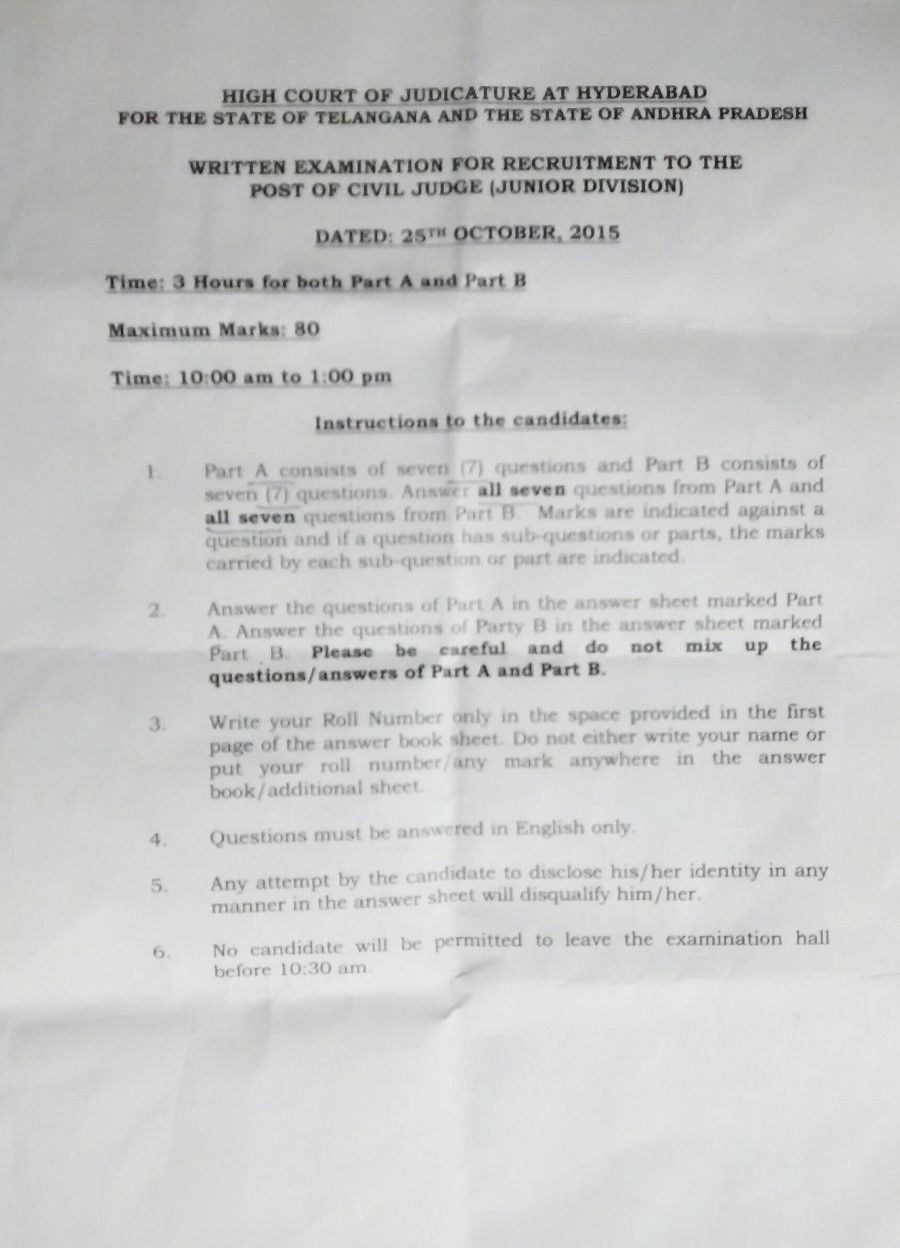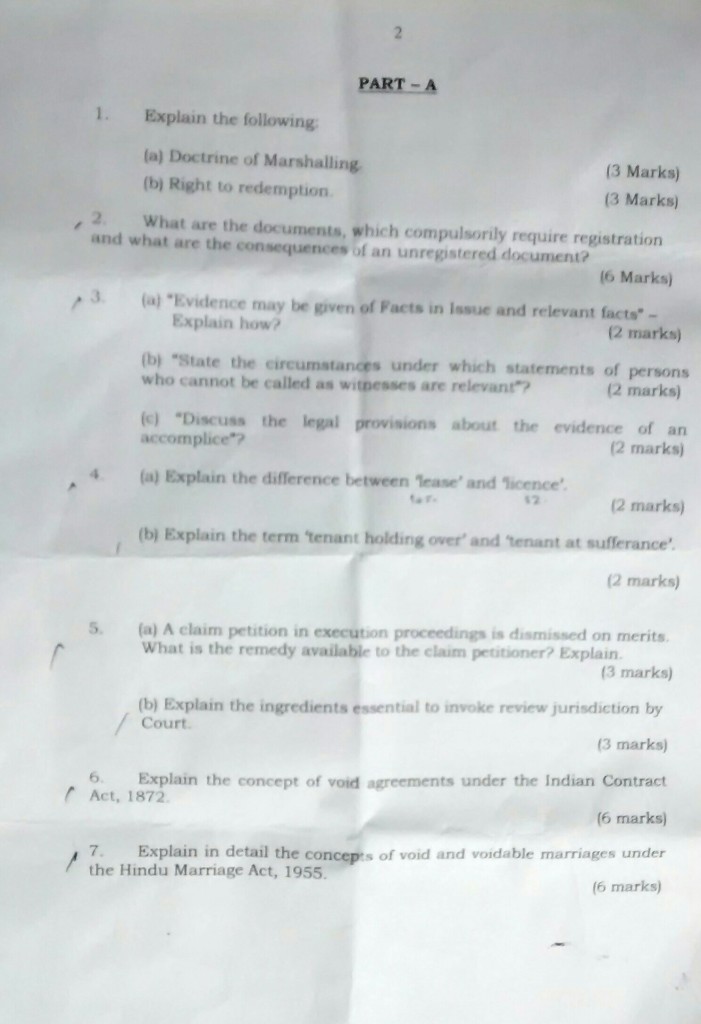PART-A
1. Explain the following:
a) Doctrine of Marshalling (3 Marks)
b) Right to Redemption (3 Marks).
a) Doctrine of Marshalling: It is explained under S.81 of the Transfer of Property Act. It recognizes right in favour of the subsequent mortgagee. The subsequent mortgagee to exercise this right the following conditions are satisfied: i) Mortgagor shall have more than one property and he should have mortgaged his properties ii) Later, the same mortgagor, mortgaged the same few or any one of those mortgaged properties to Thus, the subsequent mortgagee has a right to request, the prior mortgage to realize the mortgage debt out of the property not mortgaged to him
b) Redemption: It is explained under S.60 of the Transfer of Property Act. It recognizes right in favour of the mortgagor. The term redemption means the right of a mortgagor to get back his property or documents of title relating to property from the mortgagee on payment of debt on or before a specified time. Once the money is paid by the mortgagor, he gets the right of redemption immediately. Any stipulation forming part of the mortgage transaction & inconsistent with the right of redemption is a clog on redemption. It is void.
The redemption applies only if the entire mortgage debt is cleared. It means the person having a share in the mortgage property cannot redeem his share in the property as of a right where there are several mortgages, none of them can redeem his share alone, but any of them can redeem the entire mortgage.
2.What are the documents, which compulsorily require registration and what are the consequences of an unregistered document? (6 marks)
Ans: S.17 of the Registration Act, lists document required by law to be registered. They are: 1. Sale or exchange of immovable property of the value of Rs.100/- or upwards. 2) Simple Mortgage, 3) Instruments of gift of immovable property. 4) Other mortgages (except mortgage by deposit of title deeds) when the principal money secured is Rs.100/- or upwards. 5) Lease. 6)Instruments transferring or assigning any decree or order or award of a court of any award when such decree or award purports or operate to create, declare, assign, limit or extinguish.
Consequences of non-registration: According to S.49 of the Act, an unregistered document required to be registered under law can’t be received in evidence except in case of a contract in a suit for specific performance or as evidence of any collateral transaction not required to be effected by registered instrument.
3(a). “Evidence may be given of facts in issue and relevant facts” Explain how? (2 Marks)
Ans: To prove a case, fact shall be placed before court. However, S.5 and S.136 of the Evidence Act puts a prohibition on the court not to receive facts unless expressly recognized as relevant under the Act. They are called as relevant facts. Those relevant facts are listed under S.6 to S.55 of the Evidence Act. The term fact in issue means that relevant fact which establishes right or liability is called fact in issue. Thus, fact in issue is also a relevant fact. It is spelled out under S.13, 14 IEA.
3(b) State the circumstances under which statements of the person who can’t be called as witness are relevant? (2 Marks)
Ans: The relevant facts shall be testified by persons who perceived by their own senses. However, under certain conditions like: he is dead or incapable of giving evidence or not found or can’t be procured with unreasonable delay, any person can give evidence of his former statement subject to condition laid down under S.32 & 33 of the Act.
| Section | Kind of Fact (Former Statement) | Under what Circumstances |
| S.32(1) | Death of deceased | As to cause to his death or circumstances relating to cause of his death |
| S.32(2) | About acknowledgement of the receipt of any property or a document. | Made in the course of business or in the discharge of professional duty in books |
| S.32(3) | Statement made against the pecuniary or proprietary interest of the person making it or exposed him to a criminal prosecution or to a suit for damages. | Statement made at any time. |
| S.32(4) | Statement gives opinion as to a public right or custom or matters of general interest and it was made before any controversy as to such right or custom had arisen. | Statement made at any time. |
| S.32(5) | Statement relates to the existence of any relationship between persons. However, to be receiving as evidence, maker has special means of knowledge and it was made before the question in dispute arose. | Statement made at any time. |
| S.32(6) | Statement relates to the existence of any relationship by blood, marriage or adoption between persons deceased and is made in any will or deed or family pedigree, or upon any tombstone or family portrait, and was made before the question in dispute arose. | Statement made at any time |
| S.32(7) | Statement is contained in any deed, will or other document which relates to any such transaction as is mentioned in Section 13, Clause (a).. | Statement made at any time |
| S.32(8) | When the statement was made by a number of persons, and expressed feelings or impressions on their part relevant to the matter in question, will, or other document. | Statement made at any time |
| S.33 | 1)If the proceeding was between the same parties;2) That the adverse party in the first proceeding had the right and opportunity to cross-examination.3) That the questions in issue were substantially the same in the first as in the second proceedings. | Depositions made in a former suit or proceedings by witnesses. |
3(c). Discuss the legal provisions about the evidence of accomplice? (2 Marks)
Ans: The confession of co-accused is relevant as per S.30 Evidence Act. It can be used to prove the case against the co-accused also. Ex: (a) A and B are jointly tried for the murder of C. It is proved that A said—”B and I murdered C”. The Court may consider the effect of this confession as against B. An accomplice is a competent person to testify and it is legal to act upon his evidence though uncorroborated. However, it is settled proposition that court shall look for some kind of corroboration, even, indirect. S.114, illustration (b) of the IEA envisages the presumptive uncredit worthiness of an accomplice.























